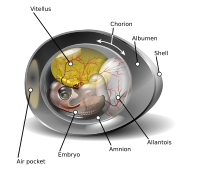
Photo from wikipedia
Background Rivastigmine is a pseudo-irreversible cholinesterase inhibitor used for therapy of Alzheimer’s disease and non-Alzheimer dementia syndromes. In humans, rivastigmine can cause significant gastrointestinal side effects that can limit its… Click to show full abstract
Background Rivastigmine is a pseudo-irreversible cholinesterase inhibitor used for therapy of Alzheimer’s disease and non-Alzheimer dementia syndromes. In humans, rivastigmine can cause significant gastrointestinal side effects that can limit its clinical use. The aim of this study was to assess the impact of rivastigmine on gastric motor function by means of electrogastrography (EGG) in experimental pigs. Methods Six experimental adult female pigs (Sus scrofa f. domestica, hybrids of Czech White and Landrace breeds; 3-month-old; mean weight 30.7 ± 1.2 kg) were enrolled into the study twice and created two experimental groups. In group A, a single intragastric dose of 6 mg rivastigmine hydrogen tartate was administered in the morning to fasting pigs before EGG recording. In group B, rivastigmine was administered to overnight fasting animals in a dietary bolus in the morning for 7 days (6 mg per day). On day 8, an intragastric dose of 12 mg rivastigmine was given in the morning to fasting pigs before EGG. EGG recording was accomplished by means of an EGG standalone system. Recordings from both groups were evaluated in dominant frequency and EGG power (areas of amplitudes). Results In total, 1,980 one-minute EGG intervals were evaluated. In group A, basal EGG power (median 1290.5; interquartile range 736.5–2330 μV2) was significantly higher in comparison with the power of intervals T6 (882; 577–1375; p = 0.001) and T10 (992.5; 385–2859; p = 0.032). In group B, the dominant frequency increased significantly from basal values (1.97 ± 1.57 cycles per minute) to intervals T9 (3.26 ± 2.16; p < 0.001) and T10 (2.14 ± 1.16; p = 0.012), respectively. In group B, basal EGG power (median 1030.5; interquartile range 549–5093) was significantly higher in comparison with the power of intervals T7 (692.5; 434–1476; p = 0.002) and T8 (799; 435–1463 μV2; p = 0.004). Conclusions Both single as well as repeated intragastric administration of rivastigmine hydrogen tartrate caused a significant decrease of EGG power (areas of amplitudes) in experimental pigs. EGG power may serve as an indirect indicator of gastric motor competence. These findings might provide a possible explanation of rivastigmine-associated dyspepsia in humans.
Journal Title: PLOS ONE
Year Published: 2023
Link to full text (if available)
Share on Social Media: Sign Up to like & get
recommendations!